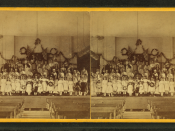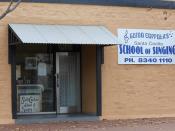THE SINGING SCHOOL: AN AMERICAN TRADITION
The Singing School was an institution that was uniquely American. it was established to serve a dual purpose: the desire to create music and the need for sociability. Generations were taught to read and sing music by itinerant singing masters, who developed characteristic methods and materials of instruction, and distinctive performance practices. Through this institution, many people were given the opportunity to participate in music, either as a singer, a teacher, or as a composer. The Singing School foreshadowed the development of church choirs and musical societies.
Early settlers in this country brought with them their native English music, both sacred and secular. They made use of various Psalters compiled in Europe. It was not until 1640, however, that the Puritan ministers in America made their own translation of the psalms. The Bay Psalm Book was the first book printed in British North America and was widely used.
The most distinguishing feature of this book was its rhymed and metered English poetry. This allowed a few tunes, having the same rhythms as the poetry, to be used as melodies for many psalms. In addition, the text employed the vernacular, and consequently promoted memorization. The ninth edition of the Bay Psalm Book, published in 1698, was the first edition published with tunes. This edition had printed the letters F-S-L-M, representing the solmization syllables fa, sol, la, and mi, under the notes. This indicates that there was a familiarity with and an interest in music instruction as applied to psalmody.
It was not until the early 18th century, however, that as a direct result of agitation by ministers for a reformation in congregational singing, arguments were advanced promoting regular singing and the eventual establishment of singing schools.
The singing school grew out of the employment...


